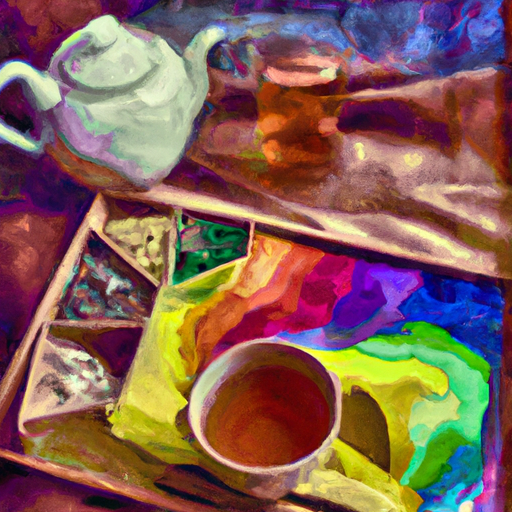Tea and Art: A Palette of Sips to Savor
“Where there's tea, there's hope.” — Arthur Wing Pinero
Behind every stroke on the canvas, every beautifully crafted sculpture, and every mesmerizing dance performance, lies an artist with a story to tell, with inspiration flowing through them. Could it be that the centuries-old practice of brewing tea might hold a key to the artistic muse inside us all? Today, we embark on a journey to explore the connection between tea and art, unveiling the intimate relationship these two seemingly disparate concepts share. Let's spill the tea! 🍃🎨
A Brief History of Tea and Art: A Love Story of the Ages
Tea has always played a significant role in the arts, transcending generations and boundaries. In ancient China, the humble tea leaf not only quenched thirst but also served as a catalyst for creativity. Tea houses were often a gathering spot for poets, calligraphers, and painters who found solace and inspiration in the company of their fellow artists and a cup of warm tea.
Japanese Zen Buddhist monks also embraced tea as an aid in their meditation, discovering how tea could sharpen their focus and heighten their appreciation of art around them. The famous Japanese tea ceremony, an integral part of their culture, became an art form in itself, influencing poetry, ceramics, and calligraphy alike.
In European societies, tea became a status symbol during the 17th and 18th centuries, with elaborate tea sets and ornate tea rooms expressing the owner's affluence, taste, and sophistication. Tea parties were a common social occasion where guests would marvel at the decorative elements adorning the table and the tea service rituals practiced by the host.
| Tea and Art - A Cultural Connection | Examples |
|---|---|
| Tea in Chinese Art | Tea house gatherings, poetry, calligraphy, ink paintings |
| Tea in Japanese Art | Zen Buddhism, tea ceremony, ceramics, calligraphy, traditional architecture |
| Tea in European Art | Rococo paintings, decorative tea sets, silverware, tea party paintings |
A table showcasing the significant relations between tea and different art forms within various cultures
Could Tea Be the Secret to Unlocking Your Artistic Muse?
The relationship between tea and our creative processes is quite profound. Tea has long been a perfect companion for introspection, contemplation, and calm moments, setting the stage for the free-flowing expression of ideas and emotions. So how exactly does tea help us tap into our artistic side?
-
A moment to pause: In the hustle and bustle of our everyday lives, it's easy to forget the importance of taking a break, to breathe and to think. Tea breaks offer a respite from the noise, providing a space for our imagination to unfold naturally.
-
A balanced brain: Tea is rich in L-theanine, an amino acid known to increase the production of alpha waves in the brain. Alpha waves are associated with a state of relaxed alertness and creativity. Combined with the energizing effect of caffeine, this might just be the perfect synergy to get our creative juices flowing after a few sips.
-
The art of mindfulness: The sensory experience of drinking tea – the aroma, taste, and warmth – encourages mindfulness, helping us to stay present and appreciate the beauty around us. This conscious awareness contributes to a stronger connection with our inner self, fueling our creative expression.
A Cup of Inspiration: Tea and Art for Everyone
Whether you're a seasoned artist or a beginner looking for inspiration, steeping into this teapotrousseau, there is a plethora of ways to incorporate tea into your artistic pursuits:
- Use tea as a medium: Tea painting is a unique and environmentally-conscious art form that utilizes different strengths of tea to create intricate designs on paper or fabric. Tea leaves can also be used in various forms of collage or mixed-media art, adding texture and depth to a piece.
- A tea-break ritual: Take regular tea breaks while working on your art projects, giving yourself a chance to step back and contemplate your work. Experiment with different tea blends and brewing techniques to find out which tea combinations work best in inspiring you.
- Tea appreciation events: Attend tea tastings or tea art workshops to explore the diverse world of tea and deepen your understanding of their cultural and artistic significance. Where there are tea lovers, there is bound to be thought-provoking conversation and creative insight.
So, critics might say discussing tea and art together is like mixing oil with water. But who knew that oil and water could blend so alluringly? Tea possesses a unique ability to inspire and ignite the creative spirit within all of us.
Join the conversation! Have you ever found creative inspiration in a delicious cup of tea? Share your stories and experiences in the comments section below. Cheers to keeping our cups - and hearts - full of inspiration! ☕🌈
